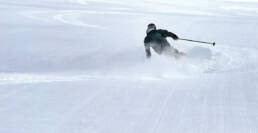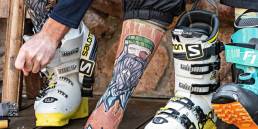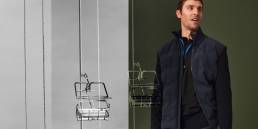There’s a coupla’ new bandits in Montana, perhaps you’ve met. Bode Miller and Andy Wirth: the former World Cup racer and the retired Squaw Valley Alpine Meadows chief. We call them bandits not because they are — though Wirth lives like John Dutton on a Bozeman ranch, and Bode’s about as close to a rodeo rider in a race course as one can get. No. We call them bandits because they’ve ridden into Big Sky country like two outlaws. Except, instead of six shooters they’re carrying a dangerous new ski design threatening to blow things up. Watch them walk in the shadow of Lone Mountain. They’re lookin’ for the sheriff, a swagger in their step.
Their weapon of choice: Peak Skis, new in 22/23. Six all-mountain boards with Bode’s signature on the back. They’re built like no other, we’ll get into that. Ten thousand will hit the slopes this winter, sold online, direct to consumer, no ski shop. Peak Skis’ design stems from a radical idea that struck Bode while riding like a rough rider on the World Cup. It took him two decades to find a backer, a true believer to help him build these skis. Now he’s got one in Andy Wirth and together they’re giving it all they’ve got. Here’s how their story’s gone down, so far, in skiing’s Wild West.
It’s the early 2000s. OutKast is singin’ Hey Ya on iPods and Bode Miller is the wild-ass ski racer everyone adores: no reins, no bridle, always going for broke. He skis every race to win. Sometimes he makes it, other times he blows up. Either way, we’re fans. He racks up nine podiums in 2002, six more in 2003, and another nine in 2004. “He’s the new Hermann, the new Tomba, the new Girardelli, the new Zurbriggen,” Swiss legend Didier Cuche tells Sports Illustrated in 2004. “In world skiing, for sure now it’s Miller time.”
Miller time is right. Every ski manufacturer wants Miller on their skis. He’s gone from K2 to Fischer. Now he’s with Rossignol and he’s skiing like a Bob Baffert thoroughbred. One day a Rossignol race technician is fussing with a VAS dampening plate on a GS ski bound for a big Bode race — the damn thing won’t stick. He ends up cutting a hole into the ski to affix the plate. On snow, with the hole, Miller feels an immediate difference: the ski is easier to turn and gives better edge. He wins the 03/04 World Cup GS Crystal Globe on that Rossignol ski. Eureka! Lightning strike.
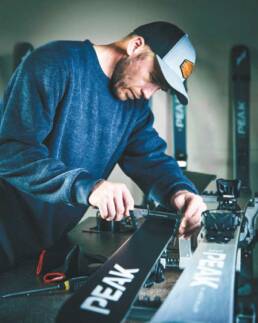
It’s the early 2000s. OutKast is singin’ Hey Ya on iPods and Bode Miller is the wild-ass ski racer everyone adores: no reins, no bridle, always going for broke. He skis every race to win. Sometimes he makes it, other times he blows up. Either way, we’re fans. He racks up nine podiums in 2002, six more in 2003, and another nine in 2004. “He’s the new Hermann, the new Tomba, the new Girardelli, the new Zurbriggen,” Swiss legend Didier Cuche tells Sports Illustrated in 2004. “In world skiing, for sure now it’s Miller time.”
Miller time is right. Every ski manufacturer wants Miller on their skis. He’s gone from K2 to Fischer. Now he’s with Rossignol and he’s skiing like a Bob Baffert thoroughbred. One day a Rossignol race technician is fussing with a VAS dampening plate on a GS ski bound for a big Bode race — the damn thing won’t stick. He ends up cutting a hole into the ski to affix the plate. On snow, with the hole, Miller feels an immediate difference: the ski is easier to turn and gives better edge. He wins the 03/04 World Cup GS Crystal Globe on that Rossignol ski. Eureka! Lightning strike.
A year later Bode jumps from Rossignol to Atomic, leaving his coveted hole skis behind. “The tech (and the skis) went to Lindsey Vonn,” he says. “He just rubbed my name off and put hers on there and didn’t tell her. So she wins (a bunch of ) races on my skis and she doesn’t know. All of sudden she’s faster and her skis are faster to ski on, and that’s it!”
Flash forward more than a dozen years: Bode is done with World Cup skiing. He’s retired from the circuit, living the SoCal life, close to the ocean and an old acquaintance of Andy Wirth. Wirth is newly retired too, from Squaw Valley Alpine Meadows but…but…well, he’s got a lot of energy, Andy does. He’s driven and restless; a guy who chomps at the bit. These two hung out at a coffee shop and went surfing. They get talking about what could be next. “I knew he wouldn’t do very well with retirement,” says Bode. Andy agrees. “Both of us pretty much sucked at retirement. “They come up with an array of plans. As Andy likes to say: “There are a lot of ideas in the Bode library.” But it’s this hole concept that’s gnawing at Bode’s brain. So Bode wants to cut a bunch of holes into a bunch of skis and prove to the world that hole technology is the next greatest thing—like Velcro and Post-it notes, one of those inventions that makes the rest of us say: Dang, I wish I thought of that.
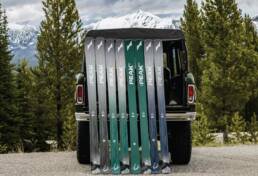
When asked what made him bet on Bode’s horse, Andy lights up like a firework. “I’m a horseman and I know that horses are always at their best when they’re free. No halter. No bridle. I didn’t learn this at business school, but I knew intuitively that we needed to take the bridle and the halter off Bode and let him run. Nothing in between his mind and the skis we make. This is a chance for Bode to do that.” He adds more soberly: “I asked myself: What would happen if I put Bode in direct line of sight of designing a ski?”
For an answer, Wirth points back to the K2 Four. Remember that ski? As a 17-year-old in New Hampshire coming up through the ranks on straight skis, Bode was obsessed with a snowboard’s sidecut. He cut one in half with a bandsaw, mounted bindings on it, and hung on for the ride. “If Shane McConkey invented the rocker,” Andy says, “Bode invented the shaped ski.”
Bode laughs. He remembers that ballsy, pesky teenage kid. He says he bugged, and bugged, and bugged his K2 rep back then to take the ski into production. “I just wore him down, every lift ride over two years, jabbering at him, finally getting them to build the K2 Four. It sold out across the country and it was enough to inspire me. I mean, I was a good skier, but I wasn’t going to make the ’98 Olympics — that ski alone allowed me to do so much more than I was capable of on a regular set of skis. I thought, Omigod, I’ve GOT to do that again.”
So now, Bode’s doing it again. Let’s zoom forward to 2021. Bode and Andy are living in Montana, where Bode is in what he calls “full jam mode”. He’s pulling all-nighters in “the lab” to make this hole technology a thing. He’s hand-making prototypes, testing them in Big Sky bowls, scrapping them, making more, and trying again. Like a mad scientist, he’s convinced the hole helps balance a board.“Skiing is a confidence game,” he says. “If you’re balanced your confidence goes up.” From beginner to expert, find the balance and “it’s magic,” Bode insists. His aim is to design one ski that works easily in a varying conditions on a whole whack of terrain.
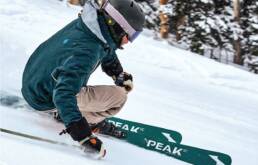
“Bode has this brilliance,” Andy says. “He’s got the capability to interact with an MIT engineer in great detail, then go out on snow and do the Chuck Yeager (test pilot) thing, saying: We need to stiffen the tail by 10 percent.”
But what is this design? What is KeyHole Technology? How is the sidecut different? Why does Bode say you only need one ski for the entire mountain instead of two or three?
Let’s start with the keyhole. There “is an oval cutaway in the upper layer of alloy in every Peak ski,” company material explains. “The cutaway creates a subtle inflection point in the ski’s longitudinal flex allowing for that easy turn initiation and smearing up front.” But it also unlocks “the ski’s torsional power” from the keyhole to the rear of the ski where, as everyone knows, “most of our edging is done.”
As for sidecut, the keyhole has allowed Bode to reduce it in wider skis. Reduced sidecut allows a ski to track well in soft and crusty snow. Which is why the company suggests you’ll only need one Peak ski. “No matter where you ski or at what speeds, the keyhole supersizes the sweet spot (balance point) of each ski in every length.”
Now it’s Winter ‘22 at Big Sky. As Bode peels through prototype after prototype, Andy Wirth has just completed the capital raise, securing trademarks, and building a unique business model and a world class team. He’s convinced the art of selling skis is due for a “refresh”, and that Peak Skis is going to be that refresh. He’s captivated by Canyon bikes’ way of doing things: purchase online, ship direct to consumer, offer a 30-day, money-back guarantee. It allows designers to be in direct contact with customers. It offers huge market penetration plus lots of feedback. And, and, the margins are good. But it’s that confidence-boosting money-back guarantee that Wirth is banking on most. Order a set of Peak Skis this season online and you have 30 days after January 1, 2023 to send them back, no questions asked. Bode and Andy call it: “de-risk”.
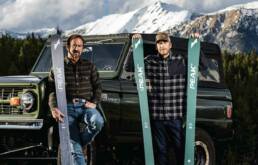
De-risk? It has to be said, Bode Miller’s been linked with boutique skis before and, frankly, it hasn’t gone so good. He hitched his wagon to Crosson Ski a few years ago but things stalled when there were production problems . Before that it was Bomber Ski, where Bode promoted bespoke, hand-crafted $2,000+ skis for an up-up-up market. Media — including SNOW — adored flashing images of Bode flying down a piste on Bomber skis, looking like 007 being chased by beautifully dangerous women. It was brilliant marketing but still, he and Bomber parted ways soon after. “I put in a good effort there,” he says, “but we had fundamental differences in opinion on things. Plus, I met incredible resistance, as I have throughout my career.”
This resistance Bode’s talking about is from manufacturers not following his ski design exactly. From K2 to Fischer, Rossignol, Head and Bomber, “I’d say I’ll switch (to your brand) but you have to do exactly as I say…. But after I switched they’d say, now we’re going to take your ideas and make them better. And they took them, but they made them not better.” Bode sighs. “There’s always been a resistance to my concepts and ideas because I didn’t have enough credibility, or because it wasn’t economically viable.”
Maybe, just maybe, this time will be different. Maybe Bode’s got the right stuff with Andy Wirth (son of a fighter pilot). While SNOW has not tested Peak Skis, reports are positive. “It can take a decade for a new company to produce a ski that merits coverage,” says ski tester and Olympian David Currier. “In year one Peak produced six podium contenders. I’ve never seen anything like it.”
And so far Andy Wirth is letting Bode do his thing. The mad scientist in the ski lab. The bandit in the ski town. The thoroughbred charging across the field bridle-less. Bode’s been given the opportunity to do exactly what he wants. Recalls Miller: “Andy asks me: Can you build a ski that’s unlike any other ski out there? And I’m like, Yes, I can. And so Andy says, Alright, I believe you. And I say Good, let’s do it. And so here we are.”
In response, Andy Wirth sounding just like John Dutton:“Yup, picked a horse and we’re riding.”
